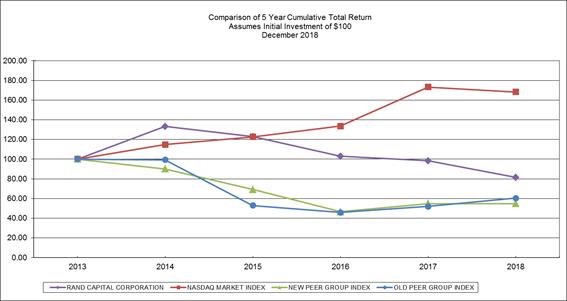Corporation Performance Graph
The following graph shows a five-year comparison of cumulative total shareholder returns for our Common Stock, the Nasdaq Market Index, and an old and new Peer Group, assuming a base index of $100 at the end of 2013. The cumulative total return for each annual period within the five years presented is measured by dividing (1) the sum of (A) the cumulative amount of dividends for the measurement period, assuming dividend reinvestment, and (B) the difference between share prices at the end and at the beginning of the measurement period by (2) the share price at the beginning of the measurement period.

Comparison of cumulative total return of one or more companies, peer groups, industry indexes and/or broad markets
| YEAR ENDED DECEMBER 31, | ||||||||||||||||||||||||
| Company/Index/Market |
2013 | 2014 | 2015 | 2016 | 2017 | 2018 | ||||||||||||||||||
| Rand Capital Corporation |
$ | 100.00 | $ | 133.22 | $ | 122.80 | $ | 102.93 | $ | 98.37 | $ | 81.46 | ||||||||||||
| NASDAQ Market Index |
$ | 100.00 | $ | 114.75 | $ | 122.74 | $ | 133.62 | $ | 173.22 | $ | 168.30 | ||||||||||||
| New Peer Group Index |
$ | 100.00 | $ | 90.09 | $ | 69.29 | $ | 46.63 | $ | 54.92 | $ | 54.75 | ||||||||||||
| Old Peer Group Index |
$ | 100.00 | 99.36 | $ | 52.83 | $ | 45.78 | $ | 51.88 | $ | 60.37 | |||||||||||||
The New Peer Group was comprised of the following companies:
Equus Total Return, Inc. (NYSE: EQS)
Firsthand Technology Value Fund, Inc. (NasdaqGS: SVVC)
GSV Capital Corp. (NasdaqCM: GSVC)
180 Degree Capital Corp. (NasdaqGM: TURN)
The Old Peer Group was comprised of the following companies:
Capital Southwest Corporation (NasdaqGS: CSWC)
Firsthand Technology Value Fund, Inc. (NasdaqGS: SVVC)
GSV Capital Corp. (NasdaqCM: GSVC)
180 Degree Capital Corp. (NasdaqGM: TURN)
We selected the New Peer Group because it is our belief that the four issuers in the group have investment objectives that are similar to ours, and among the publicly traded companies, they are relatively similar in size to us. Capital Southwest was removed from our peer group to reflect the change in their business strategy.
The performance graph information provided above will not be deemed to be “soliciting material” or “filed” with the SEC or subject to Regulations 14A or 14C, or to the liabilities of section 18 of the Securities Exchange Act, unless in the future we specifically request that the information be treated as soliciting material or specifically incorporate it by reference into any filing under the Securities Act or the Exchange Act.
15